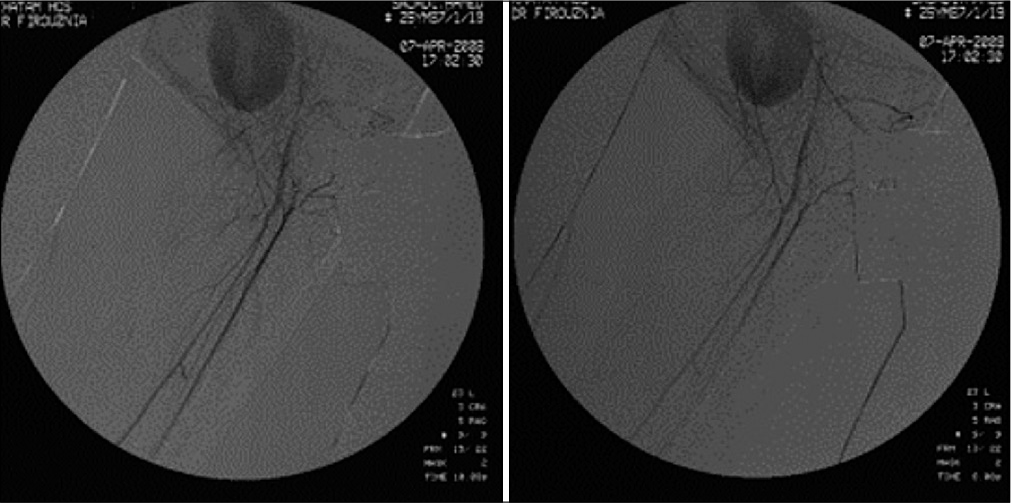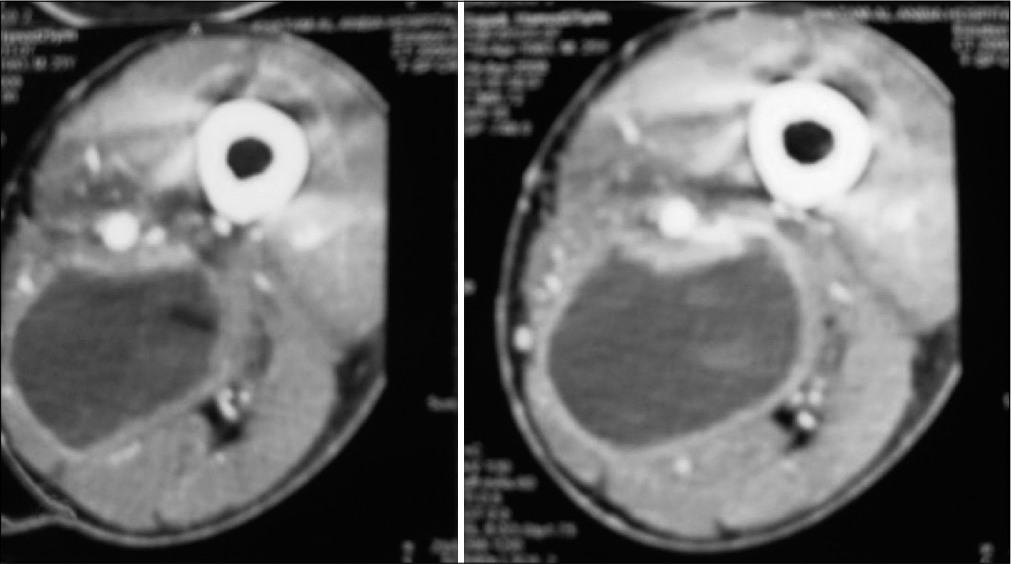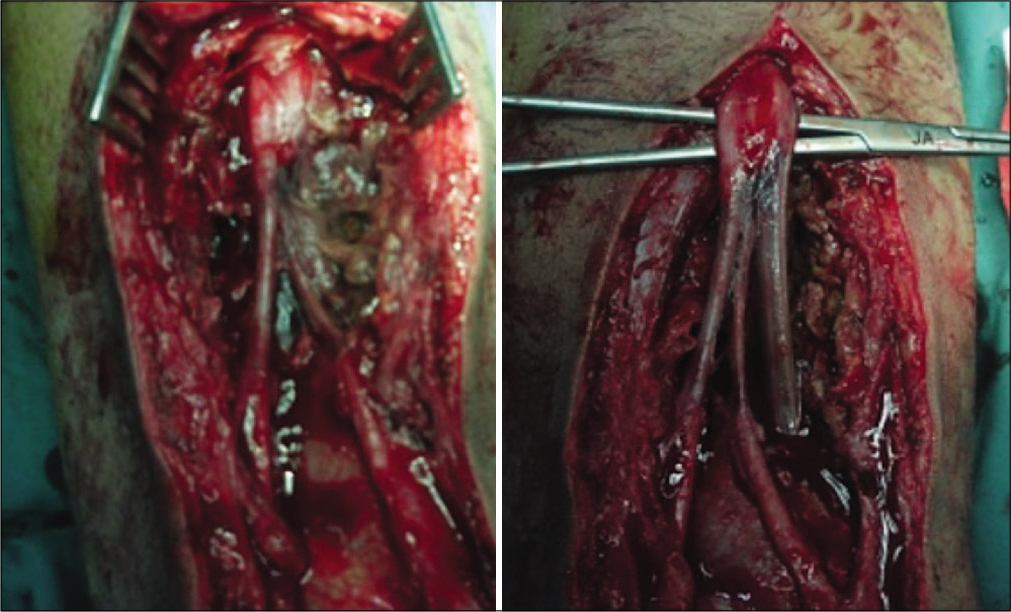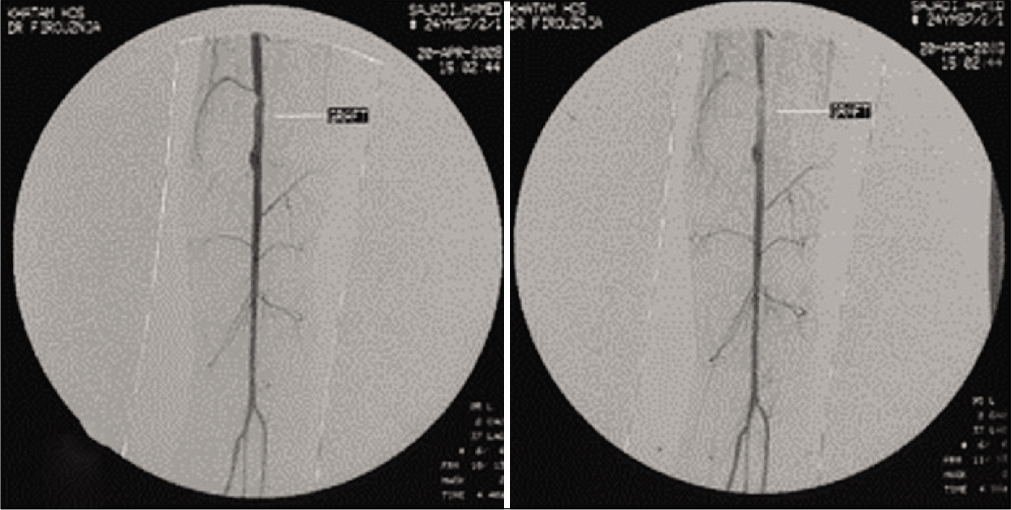- Pars Advanced and Minimally Invasive Medical Manners Research Center, Pars Hospital, Iran University of Medical Sciences, Tehran, Iran.
Correspondence Address:
Abolfazl Rahimizadeh, Pars Advanced and Minimally Invasive Medical Manners Research Center, Pars Hospital, Iran University of Medical Sciences, Tehran, Iran.
DOI:10.25259/SNI_770_2021
Copyright: © 2021 Surgical Neurology International This is an open-access article distributed under the terms of the Creative Commons Attribution-Non Commercial-Share Alike 4.0 License, which allows others to remix, tweak, and build upon the work non-commercially, as long as the author is credited and the new creations are licensed under the identical terms.How to cite this article: Abolfazl Rahimizadeh, Seyed Ali Marashi, Shahrzad Rahimizadeh, Mahan Amirzadeh, Walter L. Williamson. Peroneal/posterior tibial nerves delayed dysfunction due to traumatic popliteal artery pseudoaneurysm resulting from trivial stab wound: A case report. 30-Sep-2021;12:488
How to cite this URL: Abolfazl Rahimizadeh, Seyed Ali Marashi, Shahrzad Rahimizadeh, Mahan Amirzadeh, Walter L. Williamson. Peroneal/posterior tibial nerves delayed dysfunction due to traumatic popliteal artery pseudoaneurysm resulting from trivial stab wound: A case report. 30-Sep-2021;12:488. Available from: https://surgicalneurologyint.com/surgicalint-articles/11139/
Abstract
Background: Popliteal artery pseudoaneurysms due to stab wounds are extremely rate. Even more infrequently, they can contribute to the compression of multiple peripheral nerves.
Case Description: A 23-year-old male, following a trivial stab wound, developed the delayed occurrence of a pseudoaneurysm of the popliteal artery. This resulted in the delayed onset of a compressive popliteal/posterior tibial neuropathy. Following restoration of blood flow through the popliteal artery utilizing saphenous vein grafting, additional neurolysis resulted in resolution of the compressive neuropathy.
Conclusion: A 23-year-old male developed a pseudoaneurysm following minor trauma that resulted in peripheral nerve dysfunction.
Keywords: Concomitant peroneal, Popliteal artery, Posterior tibial nerves, Pseudoaneurysm, Trivial stab wound
INTRODUCTION
Rarely, gunshot wounds and blunt/iatrogenic traumas can cause popliteal artery injuries resulting in pseudoaneurysm formation.[
Here, we describe a 23-year-old male who, following a mild traumatic event, developed a popliteal artery pseudoaneurysm. Following saphenous vein grafting and delayed peroneal/posterior tibial nerve neurolysis, the patient’s symptoms resolved.
CASE DESCRIPTION
A 23-year-old male was admitted with weakness of his right foot of 6 weeks’ duration. About 70 days earlier, he had received several trivial puncture wounds to the upper side of his right popliteal fossa.
On examination, he had right-sided L5-distribution weakness 2/5 extensor hallucis longus, dorsiflexors 4/5 level, and numbness. Inspection and palpation of the right popliteal fossa revealed a large pulsating mass. Selective angiography revealed a pseudoaneurysm arising from the popliteal artery [
Surgical management
Initially, excision of the aneurysmal sac with restoration of arterial flow was accomplished utilizing a greater saphenous vein graft. Subsequently, neurolysis of the proximal parts of the peroneal and tibial nerves was performed [
Postoperative course
The patient’s postoperative course was uneventful. He was discharged on the 5th postoperative day with palpable distal pulses, and restoration of normal blood flow confirmed by angiography [
DISCUSSION
A pseudoaneurysm or false aneurysm develops following an unrecognized injury affecting all three layers of the artery.[
Diagnosis
Diagnosis of a pseudoaneurysm can be confirmed either with noninvasive procedures (duplex ultrasonography, CT angiography, or MR angiography) or invasively with conventional angiography.[
Treatment
Popliteal artery pseudoaneurysms can be treated with ultrasound-guided compression or percutaneous thrombin injection,[
Certainly, in those with compressive neuropathy where neurolysis of the affected nerve is a cardinal part of the management, open surgical management of the pseudoaneurysms is typically indicated.[
Outcome
The degree of postoperative neurological recovery depends on the size of the aneurysm and the preoperative duration and severity of the compressive neuropathy.[
CONCLUSION
Traumatic pseudoaneurysms should be suspected when patients develop delayed progressive neurological deficits after a penetrating vascular injury resulting in a pulsatile mass.
Declaration of patient consent
The authors certify that they have obtained all appropriate patient consent.
Financial support and sponsorship
Nil.
Conflicts of interest
There are no conflicts of interest.
Declaration of patient consent
The authors certify that they have obtained all appropriate patient consent.
Financial support and sponsorship
Nil.
Conflicts of interest
There are no conflicts of interest.
References
1. Curi MA, Geraghty PJ, Merino OA, Veeraswamy RK, Rubin BG, Sanchez LA. Mid-term outcomes of endovascular popliteal artery aneurysm repair. J Vasc Surg. 2007. 45: 505-10
2. Ersozlu S, Ozulku M, Yildirim E, Tandogan R. Common peroneal nerve palsy from an untreated popliteal pseudoaneurysm after penetrating injury. J Vasc Surg. 2007. 45: 408-10
3. Franz RW, Jump MA. Endovascular repair of post-traumatic, concomitant popliteal artery pseudoaneurysm and arteriovenous fistula. Int J Angiol. 2009. 18: 41-4
4. Megalopoulos A, Siminas S, Trelopoulos G. Traumatic pseudoaneurysm of the popliteal artery after blunt trauma: Case report and a review of the literature. Vasc Endovasc Surg. 2006. 40: 499-504
5. Nakashima M, Kobayashi M. Open repair of a giant popliteal artery aneurysm presenting with nerve compression symptoms. Vasc Specialist Int. 2021. 37: 37-40
6. Rahimizadeh A, Davaee M, Shariati M, Rahimizadeh S. Posterior tibial neuropathy secondary to pseudoaneurysm of the proximal segment of the anterior tibial artery with delayed onset. J Brachial Plex Peripher Nerve Inj. 2018. 13: e15-9
7. Woolgar JD, Reddy DS, Robbs JV. Delayed presentation of traumatic popliteal artery pseudoaneurysms: A review of seven cases. Eur J Vasc Endovasc Surg. 2002. 23: 255-9









